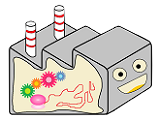Team:Gifu
From 2014.igem.org




Members&Attributions
Team members
We are the first team of Gifu University that attend iGEM Jamboree. Our team consists of 9 undergraduates and 3 instructors. We conduct the experiment until night every day. We enjoy iGEM through discussing the future plan, creating the team wiki, and communicating with other iGEM teams.
Undergraduates
 Akihiro Moriyama
Akihiro MoriyamaRole: Team leader
Grade: junior
Comment:
He that falls today may rise tomorrow.
 Kenta Nomura
Kenta NomuraRole: Project leader
Grade: junior
Comment:
It is no use crying over spilt milk.
 Wataru Fukuda
Wataru FukudaRole: Wiki designer
Grade: junior
Comment:
Everything comes to those who wait.
 Yusuke Banno
Yusuke BannoRole: Poster designer
Grade: junior
Comment:
Without haste, but without rest.
 Sachi Asano
Sachi AsanoRole: Wiki designer
Grade: junior
Comment:
∠( `°∀°)/
 Yuki Kamijo
Yuki KamijoRole: Language translator
Grade: junior
Comment:
The game is on!
 Momoko Yamada
Momoko YamadaRole: Language translator
Grade: junior
Comment:
Long sleeeeeeeeeeeeeeeper
 Tomoya Kozakai
Tomoya KozakaiRole: Experimenter
Grade: junior
Comment:
I cannot deny the possibility, but it is not my fault.
 Takema Hasegawa
Takema HasegawaRole: Experimenter
Grade: junior
Comment:
I love vinegar and caffeine.
Collaborator
 Chiaki Ishizuka
Chiaki IshizukaInstructors
 Akio Ebihara
Akio Ebihara Satoshi Iwamoto
Satoshi Iwamoto Hitoshi Iwahashi
Hitoshi IwahashiAttributions
Our cooperators provided us with a lot of supports. But for their help, we could not have succeeded our projects. We would like to thank our instructors and all advisers who have assisted our projects. Additional supporters listed below.
General support
- Professor A. Ebihara: As a main instructor, he gave us an opportunity to found our team "iGEM Gifu", helped us order reagent and primer, adviced us about our experiment, worked on other professors, prepared the environment so that we can conduct our project, and so on.
- Professor S. Iwamoto: As a main instructor, he worked on the university, helped us practice our presentation, adviced us about our experiment, and so on.
Laboratory support
- Professor H. Iwahashi: He lent us laboratory and some devices, and offered us some equipments. And also, he cooperated on the foundation of iGEM Gifu.
- Professor K. Nakamura: He cooperated with preparing our Internet environment in the laboratory.
Technical support
- Professor T. Yabe: He advised us the method of our experiments, such as Western-Blotting and determination of mRNA quantity.
Spetial Thanks
- We appreciate all of laboratories and other professors offering us great environment for our works.


WELCOME TO iGEM 2014!Your team has been approved and you are ready to start the iGEM season!
|
||||||||||||||||||||||
| ||||||||||||||||||||||
Theme of our project |
||||||||||||||||||||||
-
Transform new year's card to rice cake (make cellulose resolve and reconstruct it to synthesize amylopectin)
-
RNA shaped like a ring / ring-shaped RNA (mass-produce protein by ring-shaped RNA)
Description |
-
Today paper is used in quantity every day and will be waste after use. In Japan, for example, they send new year's card to relations, friends and acquaintances every year. So some cards are thrown away when it is written incorrectly, stained or sent from disagreeable person. It is a sheer waste to throw away many cards, so it is great idea that we transform card into MOCHI, tranditional Japanese food made from rice and composed of amylopectin. Paper contains cellulose, and both amylopectin and cellulose are polyglucose. Why we can't the transformation?
We genetically modify Escherichia coli and make 2 type of function. One of the function is synthesis of cellulase, which is enzyme analyzes cellulose into glucose. Another is synthesis of amylopectin synthetic enzyme. We use them to analyze cellulose (it compose new year’s card) and synthesize amylopectin (it is main ingredient of MOCHI). In 2008, the iGEM team of the University of Edinburgh studied reducing cellulose to glucose. We refer to this study and improve it to reduce cellulose. On the other hand we introduce gene coding amylopectin synthetic enzyme from Oryza sativa into E.coli to synthesize amylopectin in body of E.coli. In fact, E.coli have a function to synthesize glycogen from glucose in natural. So we use some parts of this function and remove some of them to realize the efficient transformation.
-
In vivo, proteins are synthesized in transcription and translation. Generally, mRNA is single-strand RNA, starting translation by binding ribosome on initiation codon, and ending by separating ribosome from mRNA. In this study, we aim to build the method of synthesizing long-chain, massive proteins and to improve translation efficiency. That is, allowing ribosomes to have a semi-permanent translation mechanism by producing circular mRNA and causing a defect of termination codon. To cyclize mRNA, we can use a splicing mechanism of T4 phage. Splicing is a mechanism removing circular introns which don't code for proteins and joining in exons which code for ones. It occurs after transcription. Splicing is catalyzed by several base sequences of the ends of introns as a ribozyme, being subjected to nucleophilic attack from introns to exons. So we will introduce the plasmids which place the sequence of the end of introns as a splicing ribozyme on the end of a gene coding for proteins into E.coli, and cyclize mRNA for synthesis of long-chain, massive proteins.
 "
"
